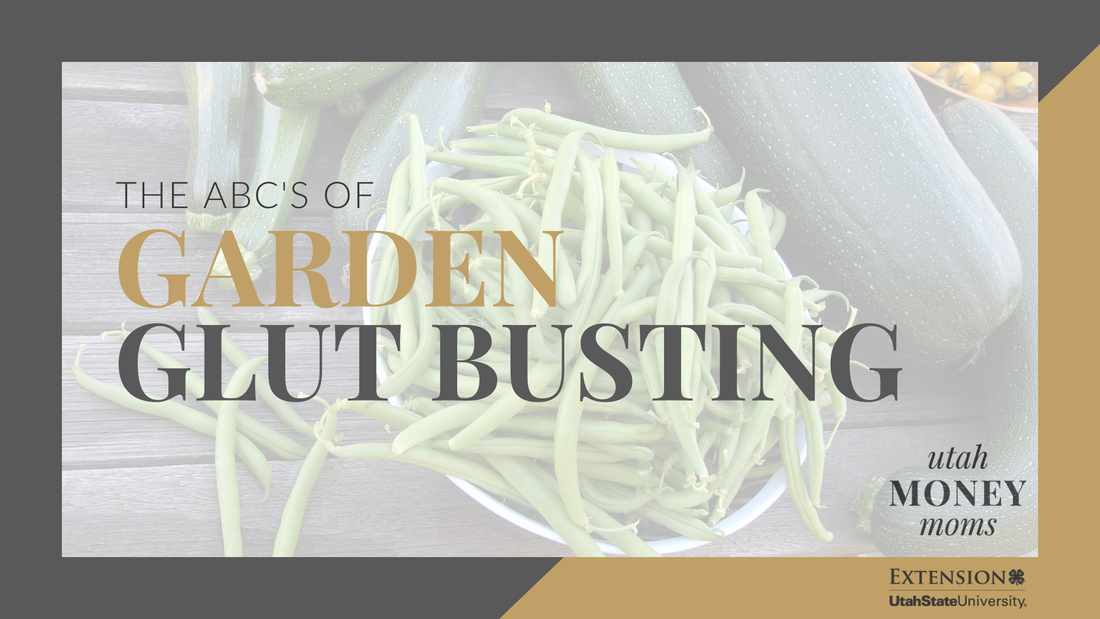|
Guest Contributor: Andrea Schmutz, Assistant Professor, USU Extension  If you grew a garden this year, you might be at the point where you look at the plants loaded with produce and ask, “What do I do with all of this?” As Maria (Julie Andrews) in the Sound of Music said, “Let’s start at the very beginning, a very good place to start. When you read, you begin with ABC…” So, taking Maria’s advice, and in honor of school starting, here are the ABCs of garden glut busting. A is for assisting your children in setting up their own mini farmer’s market in your front yard. Help them make signs with simple pricing and encourage them to have a goal for which they are saving. That way, when someone stops to look at the produce, they can say “we are selling our garden produce to help save money for our family vacation” or whatever their financial goal is. I remember stopping at such a stand because I was intrigued by the childish handwriting on a sign that said “vegetables 25 cents”. I had my own garden but couldn’t resist buying something from the cute kids who told me they were saving money for college and got up at 6:00 am to pick the vegetables so they would be fresh.
B is for bags of fruits or veggies that make great neighbor gifts! Gather up some of your fresh produce and deliver it to people in your neighborhood who may not grow a garden. During COVID, I would imagine that many people would be excited to receive fresh produce without having to go to the store. C is for canning your fruits and vegetables so you can enjoy your harvest throughout the year. Imagine the sound of popping open a jar of homegrown tomatoes or peaches in the middle of winter and celebrating the fruits of your labors. Pure deliciousness! My family especially loves our tradition of chips and home canned salsa on a Sunday afternoon. What I love is the conversations that result as we reminisce over all of the hard work and fun that went into growing the produce and making the salsa. Priceless! If you’d like to learn about canning your produce, please check out USU Extension’s Preserve the Harvest/canning website. D is for drying, or dehydrating, fruits and veggies. You can mix the dried fruits and veggies into any number of recipes from granola and power mixes, to soups and stews. You can powder them and sneak them into breads, muffins or pancakes to add a nutritional boost. For dehydrating tips, visit USU Extension Preserve the Harvest/drying. E is to remind you to enjoy your fresh produce! Get creative and see if you can serve produce from your garden at every meal. I love to try to make a whole dinner just using produce from our garden. Have your children help in the garden. Show them how to harvest the produce so when you need ingredients for a meal, they can “shop” in the garden for you. You might be surprised at what children are willing to eat when they help grow the food. Even my “picky” eaters will eat sliced tomatoes and onions when they know it came from our garden! Try tuna stuffed tomatoes, cucumber and onion salad, bruschetta, or cold zucchini and yellow squash soup. F is for freezing fruits and vegetables to be used at a later date. You can freeze apples or berries in the quantities you need for when you want to whip up a quick pie. Vegetables can be frozen for later use in stir fry, pasta dishes, soups and stews. For information on freezing fruits and vegetables, visit USU Extension Preserve the Harvest/freezing. G is for giving some of your garden bounty to the local food pantry or soup kitchen. Not sure what to do? Read “Top 13 Vegetables to Donate to Food Pantries” for tips on how to help your local food pantry. H is for herbs that are one of the most commonly tossed fresh foods. Did you know that you can actually freeze your fresh herbs? Chop them up or blitz them in the food processor, place them in ice cube trays and cover with olive oil or water. Once frozen, store in airtight containers in the freezer and they are ready to throw into soups, stews, pestos, and curries. I is to invite others to glean in your garden. Some communities actually have gleaning clubs who will gladly come pick your extra fruits and vegetables. If you don’t have a gleaning club in your area, you could post something on social media or put a sign in your yard inviting your neighbors or those you know to come enjoy your bounty. I realize I did not make it all the way through the alphabet, but hopefully this shortened version of the ABCs gave you some ideas to use your garden glut. Pick a few of the ideas, maybe one or two that you haven’t yet tried, and go out and become a garden glut buster! Happy harvesting! Parting thought: “Don’t judge each day by the harvest you reap, but by the seeds that you plant.” - Robert Louis Stevenson
0 Comments
Your comment will be posted after it is approved.
Leave a Reply. |
TAKE A FREE CLASS!Host a ClassamandaSharing real-life money smarts to help you stay on track with financial goals while still enjoying life! Follow the fun on InstagramAS SEEN ONawardsBest of State 2022 & 2023: Personal Finance Education
1st Place National Award in Social Media Education from the National Extension Association of Family and Consumer Sciences
Gold Award in Blog Site category at the 7th annual Education Digital Marketing Awards.
Platinum Award in Digital Media, Web Design category at the International Marketing and Communication Awards.
Categories
All
|








